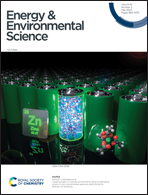Revealing the underlying solvent effect on film morphology in high-efficiency organic solar cells through combined ex situ and in situ observations†
Abstract
The morphological features and the film formation processes in high-performance donor–acceptor binary photovoltaic blends cast from three representative solvents are carefully investigated and analyzed. The PM6:L8-BO system shows a very significant efficiency change on varying the solvent from chloroform (CF) to chlorobenzene (CB) and o-xylene (XY), whereas the PM6:eC9 system shows limited influence of the solvent used. Ex situ characterization studies have revealed that CB and XY cause too-pronounced phase separation for PM6:L8-BO. In contrast, PM6:eC9 films display only slightly enhanced phase segregation in CB films and even better mixing in XY-processed films. The in situ observations further reveal that the PM6 aggregation-dominated stage during film formation is longer for the eC9 system than for L8-BO, effectively suppressing the separation of donors and acceptors. PM6 is found to be highly miscible with the acceptors when processed from XY. The ex situ analysis results correlate well with the device performance and are finely explained by the in situ and miscibility study. Furthermore, an excellent device efficiency of 19.10% (verified 18.77%) is achieved using a ternary design for XY-enabled organic solar cells (OSCs) with PTQ10, while the corresponding blade coating devices present an excellent PCE of 18.25%. Thereby, this work provides a clear understanding of film morphology formation and enables the realization of high-performance non-halogenated solvent-processed OSCs.



 Please wait while we load your content...
Please wait while we load your content...